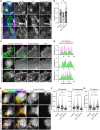DLC1 promotes mechanotransductive feedback for YAP via RhoGAP-mediated focal adhesion turnover
- PMID: 38563084
- PMCID: PMC11112125
- DOI: 10.1242/jcs.261687
DLC1 promotes mechanotransductive feedback for YAP via RhoGAP-mediated focal adhesion turnover
Abstract
Angiogenesis is a tightly controlled dynamic process demanding a delicate equilibrium between pro-angiogenic signals and factors that promote vascular stability. The spatiotemporal activation of the transcriptional co-factors YAP (herein referring to YAP1) and TAZ (also known WWTR1), collectively denoted YAP/TAZ, is crucial to allow for efficient collective endothelial migration in angiogenesis. The focal adhesion protein deleted-in-liver-cancer-1 (DLC1) was recently described as a transcriptional downstream target of YAP/TAZ in endothelial cells. In this study, we uncover a negative feedback loop between DLC1 expression and YAP activity during collective migration and sprouting angiogenesis. In particular, our study demonstrates that signaling via the RhoGAP domain of DLC1 reduces nuclear localization of YAP and its transcriptional activity. Moreover, the RhoGAP activity of DLC1 is essential for YAP-mediated cellular processes, including the regulation of focal adhesion turnover, traction forces, and sprouting angiogenesis. We show that DLC1 restricts intracellular cytoskeletal tension by inhibiting Rho signaling at the basal adhesion plane, consequently reducing nuclear YAP localization. Collectively, these findings underscore the significance of DLC1 expression levels and its function in mitigating intracellular tension as a pivotal mechanotransductive feedback mechanism that finely tunes YAP activity throughout the process of sprouting angiogenesis.
Keywords: Angiogenesis; DLC1; Endothelium; Focal adhesion; Force; Integrin; Mechanotransduction; Migration; Rho GTPase; Stiffness; YAP/TAZ.
© 2024. Published by The Company of Biologists Ltd.
Conflict of interest statement
Competing interests The authors declare no competing or financial interests.
Figures






References
-
- Amin, E., Jaiswal, M., Derewenda, U., Reis, K., Nouri, K., Koessmeier, K. T., Aspenström, P., Somlyo, A. V., Dvorsky, R. and Ahmadian, M. R. (2016). Deciphering the molecular and functional basis of RHOGAP family proteins: a systematic approach toward selective inactivation of RHO family proteins. J. Biol. Chem. 291, 20353-20371. 10.1074/jbc.M116.736967 - DOI - PMC - PubMed
Publication types
MeSH terms
Substances
Grants and funding
- NWO-VIDI grant 016.156.327/Nederlandse Organisatie voor Wetenschappelijk Onderzoek
- 03-002-2021-T087 Established Investigator Dekker grant/Hartstichting
- Amsterdam Cardiovascular Sciences, Amsterdam University Medical Centers
- European Research Area Network on Cardiovascular Diseases
- VIDI 016.156.327/Nederlandse Organisatie voor Wetenschappelijk Onderzoek
LinkOut - more resources
Full Text Sources
Molecular Biology Databases
Research Materials

